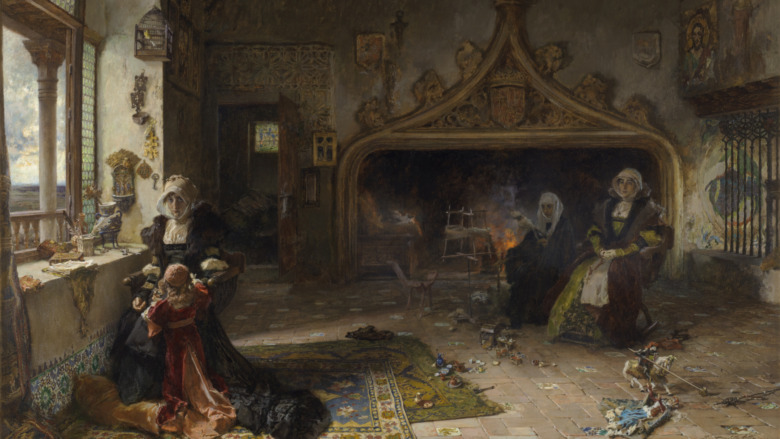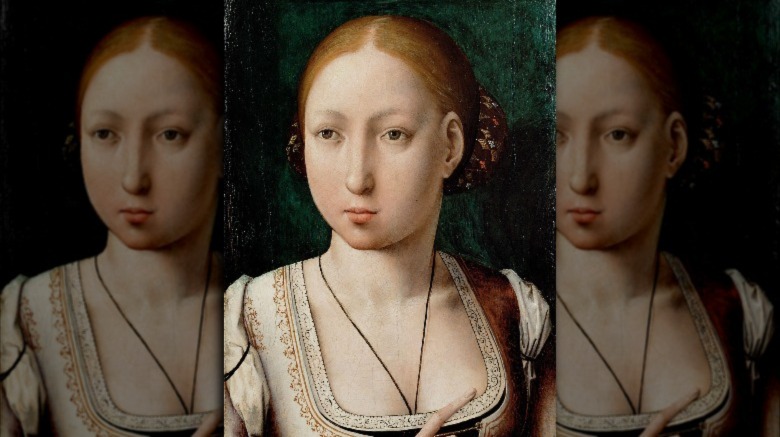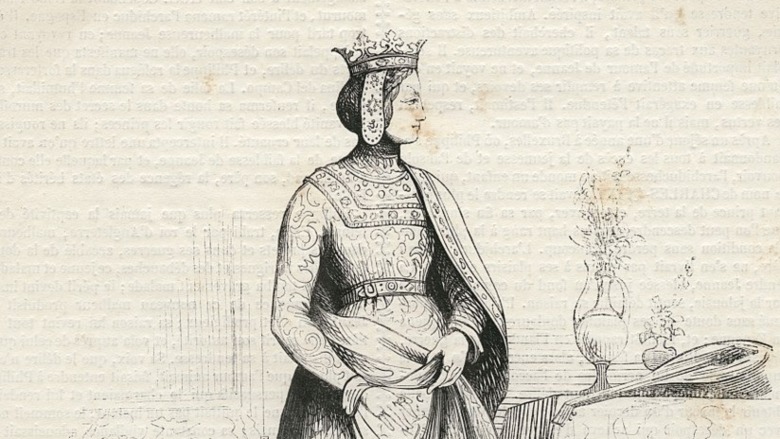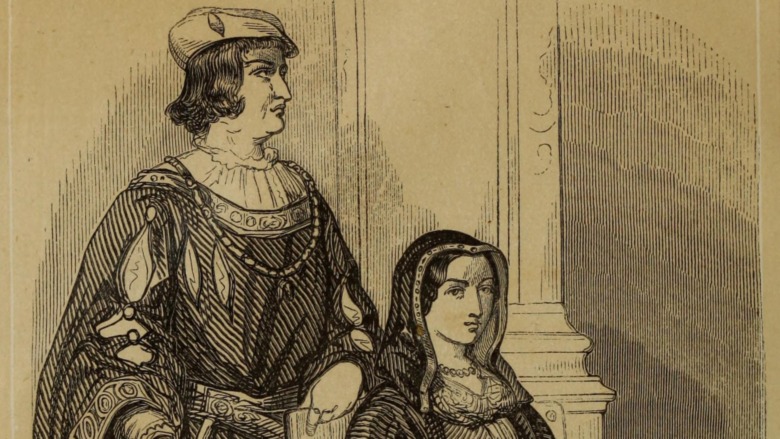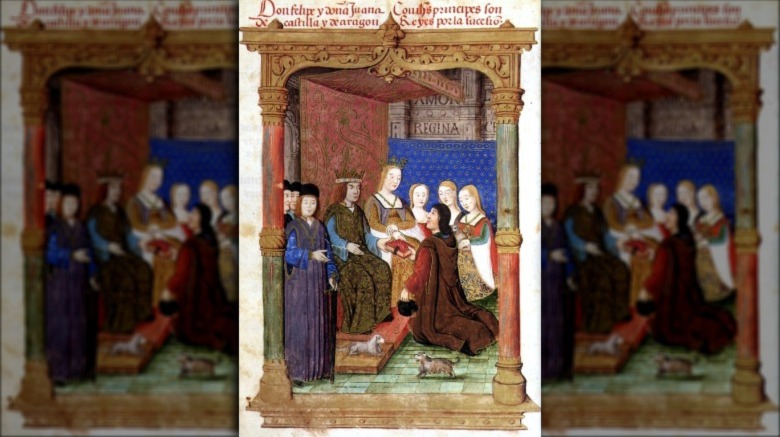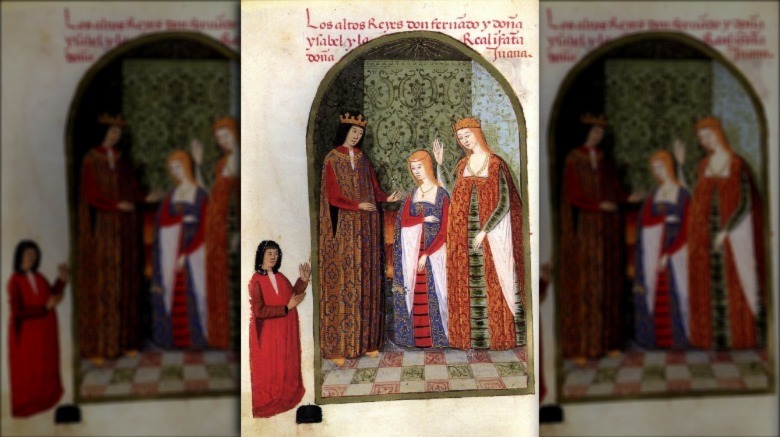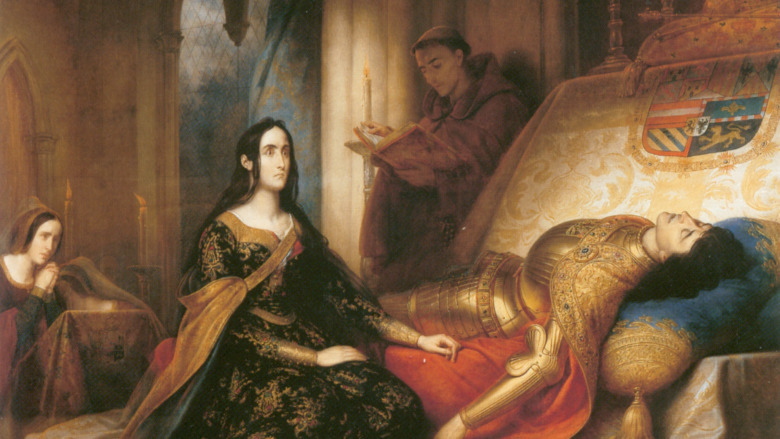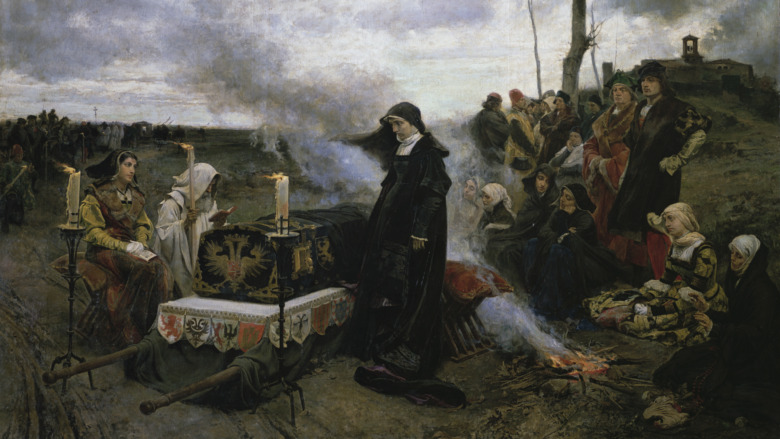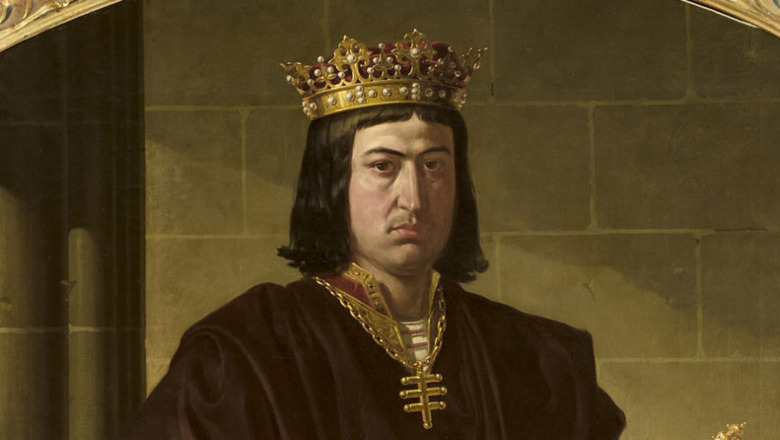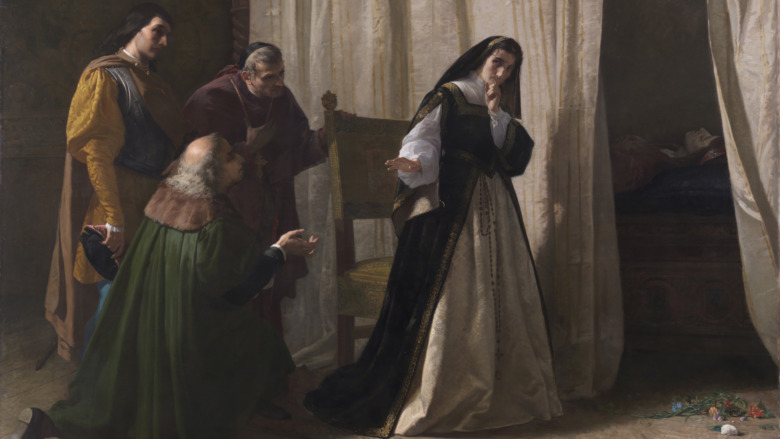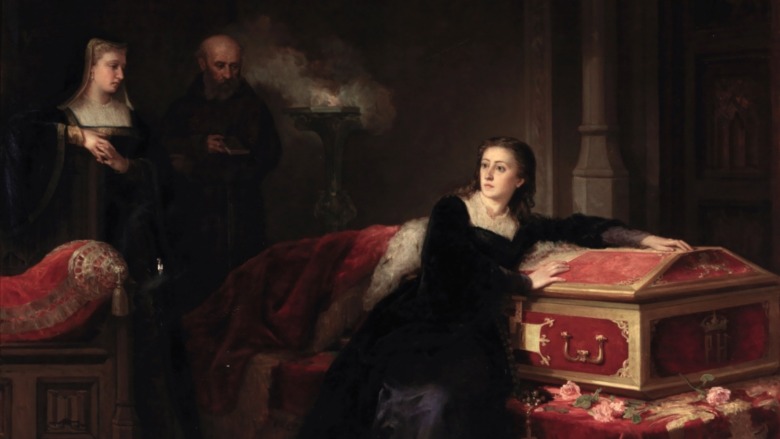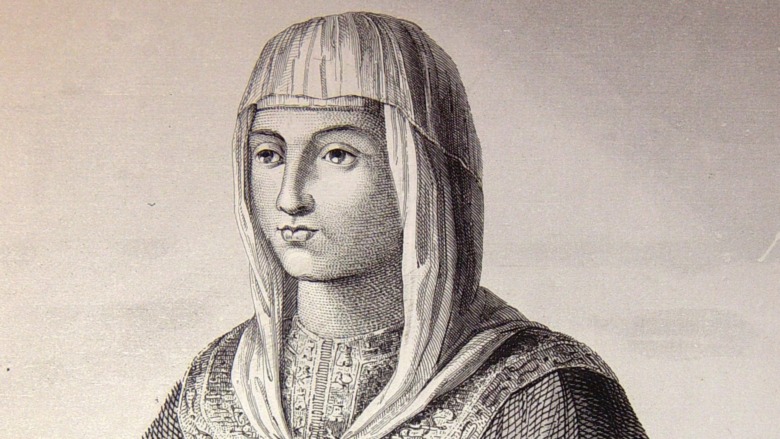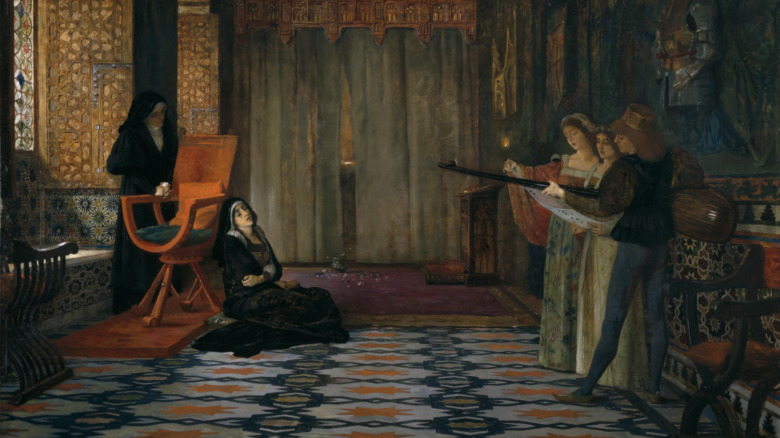The Tragic True Story Of Joanna The Mad
A few centuries ago, not only were royals subject to intense scrutiny, but they would have been squarely at the center of European power. That placed them in a position to make real changes, sure, but it also effectively painted a target on various royal backs throughout history. Even if that didn't prove to be a deadly situation — as it certainly did for quite a few unfortunate royal heads — it could get one trapped in a pretty dire situation while others struggled for control.
That's what happened when Joanna of Castile found herself in the intense 15th and 16th centuries. As the daughter of Spanish royals who led the intertwined kingdoms of Castile and Aragon, Joanna was already born to riches, but, as the third child, likely didn't expect any real power. As various tragedies in her life unfolded, however, she grew ever closer to power and, as many accounts maintain, began to crumble under the pressure. She dealt so poorly with the situation that it's said she was lost to mental illness, earning the title of "Juana la Loca" or, in English, "Joanna the Mad."
But Joanna's story isn't quite so simple. Some argue that she was a woman whose potential influence was ripped away by power-hungry relatives who had a stake in portraying her as unstable and unfit to rule. Today, a few historians wonder if she was "mad" at all. Wherever the real truth lies, it's clear that Joanna's story is a real tragedy.
Joanna wasn't some minor royal
Though some modern readers might not recognize Joanna of Castile (or Juana, as she would have been called by those around her), this modern lack of recognition doesn't mean that Joanna herself wasn't kind of a big deal. In fact, as the daughter of power duo King Ferdinand II of Aragon and Queen Isabella I of Castile, Joanna was a serious player in European politics.
At first, according to Encyclopedia.com, she was admittedly the backup to a backup to a backup when she was born in 1479. As the third child of Isabella and Ferdinand, the throne of the two Spanish kingdoms probably seemed far away indeed. First in line was prince Juan, then the king and queen's only son. If something happened to him, then the thrones would go to their eldest child, Isabella of Asturias.
Eventually, Joanna was joined by other siblings. Her younger sister was Catherine of Aragon, the ill-fated first wife of England's Henry VIII. She was also well-educated like the rest of her siblings, speaking both Latin and French along with the languages of her region, as The Tudor Society reports. Yet, though she was said to be both intelligent and beautiful, not to mention rich and in a fairly powerful position as the daughter of two formidable royal parents, life would not be entirely easy for Joanna.
Joanna the Mad was maybe a religious rebel
As king and queen of two Spanish kingdoms, Joanna's parents saw themselves not only as monarchs reigning over an earthly, temporal realm, but as religious leaders. They were also, according to History, deeply suspicious of their own church. Both Isabella and Ferdinand believed that Jewish people who had converted to Christianity, known as "conversos," were secretly corrupting the church from within. Their antisemitism kicked off the infamous Spanish Inquisition, a medieval moral panic that included the torture and execution of many who didn't fall into step with the religious rules of the time.
Though her parents were so devoted to the faith that they were willing to enact state sponsored killings over the matter, Joanna herself showed some skepticism around religion. According to letters from court attendants quoted in the Calendar of Letters, she appears to have been subject to torturous punishments meant to keep her in the faith or at least keep her in line, including a rope-based affair known as "la cuerda" that was "applied to preserve her life" and, at one point in her later life, used to make her attend Catholic mass.
However, this tale needs to be taken with a grain of salt. Juana of Castile notes that 19th century historian G.A. Bergenroth may have been too invested in romanticizing this episode of Joanna's life. He argued that Isabella feared Joanna was a heretic, though the actual evidence for this claim is scanty.
Joanna married at age 16
Though young by today's standards, it wasn't beyond the pale for a teenage royal to wed in 1496, when Joanna married the 18-year-old Philip of Flanders, son of the future Holy Roman Emperor Maximilian I. It was, as Town & Country says, a politically important marriage in a family that was very set on strengthening Spain and its relations to other European powers. As part of the dynastic deal, Maximilian also agreed that his own daughter, Margaret, would wed Isabella and Ferdinand's heir, Juan.
Joanna eventually moved to Flanders and had a proper wedding just north of modern-day Brussels in October 1496. She was in a bit of an odd position, according to Juana of Castile. She arrived without a traditional dowry, under the agreement that all of Philip's lands and income would support her instead. This left Joanna without money or influence of her own, leaving her in a poor position to support her parents' interests at court. Apparently not understanding or caring about Joanna's isolation and powerlessness, they sent a series of ambassadors to the Burgundian court.
Marital problems may have contributed to Joanna's behavior
Contributing to Joanna's feelings of isolation and disenfranchisement were surely her problems with Philip. That would have been surely surprising to anyone who witnessed their first in-person meeting. Per Encyclopedia.com, the story goes that the two were so utterly taken with one another that they ordered a priest to get them married that minute so they could then get straight to the wedding night activities. They would later go on to have six children together, including two future Holy Roman Emperors, while the remaining four daughters would become various queens.
Yet, as with so many relationships that start off with flaming passions, things appear to have fizzled rather quickly. According to Town & Country, Philip simply couldn't keep it in his pants. Even worse, he didn't have the dignity to keep things quiet, which may explain some of Joanna's outbursts. She appears to have first suffered from recorded bouts of anger and depression from this time period, at least. Philip also repeatedly tried to control his wife as she became more politically powerful, which put further stress on their marriage.
After a series of family deaths, Joanna became the heir to two kingdoms
Few, if any people expected Joanna to secure any real political power in her life. There were her parents, after all, who were some of the strongest and most notable European monarchs of the age. And anyway, even after they died, their son Juan would take over. If the very worst happened, then there was always the eldest sister of the bunch, Isabella of Asturias, not to mention her own descendants. Joanna was, effectively, the spare's spare.
Then, Juan died in 1497. Per The Tudor Society, it looked as if his young wife, who was pregnant at the time, would give birth to an heir. Yet, Juan's infant daughter was stillborn. The line of succession moved on to Isabella of Asturias, who died the next year after giving birth to her own child, Miguel. The thrones would have then gone to him, but young Miguel died in 1500. Therefore, it was all left to Joanna, who was now the heir not only of Castile, but also Aragon.
This suddenly made Joanna a much more prominent power player in Europe, and also a political target. Soon enough, even her surviving family members were eyeing Joanna as a potential rival.
Joanna's behavior alarmed those around her
Even before Joanna became the queen of Castile and Aragon, there were rumors that she was mentally unstable. The trouble seems to have started when Joanna visited her ill mother in 1504, as the Journal of Humanistic Psychiatry reports. For some undisclosed reason, the two fought and Joanna — who hadn't been eating or sleeping regularly, according to accounts — wanted to return to Flanders immediately. However, this meant that she would have to travel through France. As Castile and France were at war, trying to return home by this route was deemed dangerous. Joanna was therefore forbidden from leaving.
Joanna reacted by screaming and striking the building where her horses were stabled. She then stayed up all night in protest, stringently refusing any help or attempts to get her to come inside. According to many accounts, this is the first time that she exhibited what some deemed to be "unreasonable" behavior.
Other sources, such as Britannica, allege that her fixation on husband Philip's unfaithfulness may have been an early sign of instability, though it's equally easy to argue that Joanna was then simply acting out because of her husband's philandering. Anyone who's dealt with a roving partner can likely sympathize with Joanna's melancholy. Either way, it appears that allegations of her "madness" arose well after her marriage, sometime around 1504.
The death of her husband seriously hurt Joanna
It appears that Joanna's mental health took a turn for the worse after the death of her husband. At that point, as the Journal of Humanistic Psychiatry reports, she was already conveniently "mad" enough that, upon her mother's death, both Ferdinand and Philip agreed that Joanna should be booted as the ruler of Castile. Both had already tried to legitimize their individual takeovers of Castile by minting coins with Joanna and their respective faces on the currency. Ferdinand eventually gave up his claim and allowed Philip to become regent for Joanna. Then, Philip died.
He'd been taken down by an unspecified fever, but the cause of his death wasn't nearly as important as its aftermath. A pregnant Joanna reportedly refused to part from his remains as they were carried to his burial place in Granada, according to a rather dramatic account in History of the Reign of Ferdinand and Isabella. Joanna is said to have carried on to the point where she stopped bathing and wouldn't sleep in beds, all in an effort to remain close to Philip's body.
However, the most colorful versions of this story may be more myth than fact, as The Sixteenth Century Journal argues. Indeed, during his lifetime, Philip is recorded as having criticized his own father-in-law for trumping up the madness of Joanna. It's very possible that the story of a deeply unstable, mournful Joanna trailing ghoulishly after Philip's coffin is a political and artistic invention.
Her father yanked Joanna's power out from under her feet
Though he was unsuccessful in earlier attempts to take power over Castile, Ferdinand became the de facto ruler of the region when he had Joanna imprisoned at a monastery in 1506, shortly after Philip's death and the rumors of her madness began to circulate more widely. Per Town & Country, she allowed him to become regent in 1507. It must have been a pretty tense negotiation, however, as Joanna was kept hidden away in a castle and allowed very few visitors. Her own father is said to have visited her only twice more in her life.
To achieve his goals, Ferdinand apparently had to carefully spin the situation, even to Joanna's sister, Catherine of Aragon. According to Sister Queens, Ferdinand wrote to his daughter Catherine that he simply had to take over Castile and make sure things were running correctly, given that Joanna was not fit to do so.
He also seems to have spread the rumors that Joanna was strangely fixated on Philip's corpse, even going so far as to say that she had refused to let his remains finally be buried. He conveniently neglected to say that Joanna was actually pretty set on burying Philip in Granada. This could have proven to be politically inconvenient for Ferdinand, who wanted his former son-in-law deposited elsewhere.
No one is sure what mental illness may have hit Joanna the Mad
Because of the political complexities of the time and unclear records, it's not obvious what kind of disorders might have affected Joanna. Based on her family history, some researchers suspect her illness may have had a genetic component. According to the Journal of Humanistic Psychiatry, her grandmother Isabella of Portugal was reportedly locked up in a castle by her own stepson, who claimed that his stepmother was suffering from a mental illness and needed to be contained. Maidens and Manuscripts likewise reports that Joanna's grandson, Carlos, and great-granddaughter Maria, both struggled with their mental health.
Even with a possible genetic link — assuming that Isabella of Portugal was genuinely ill and not just politically inconvenient like her granddaughter — it's hard to pin down just what might have been afflicting Joanna. Reports of her intense moods and dramatic, even violent reactions to various life events might indicate borderline personality disorder. Her moods might also be linked to depression or bipolar disorder, perhaps exacerbated by a poor support system and a generally stressful life in the midst of a major European power struggle. Some even guess that she may have suffered from schizophrenia, linked to her purported struggles with paranoia and delusion.
Ultimately, however, we can't be sure what may have plagued Joanna. Without the chance for her to meet with a modern psychiatrist or other mental health professional, it's impossible to accurately diagnose her.
It's possible that Joanna the Mad wasn't so mad after all
With the pressures of a cutthroat family and multiple thrones, it's no wonder Joanna may have acted out in fear, anger, and desperation. So, too, could the cascade of family deaths, from her siblings, to her mother, to her own beloved and problematic husband, have shaken Joanna to her core.
It's telling that, as Maidens and Manuscripts points out, reports of Joanna's "madness" only seems to have escalated after these family tragedies put her squarely at the center of power in 16th century Europe. Remember also that Joanna and Philip had six children over the course of their nearly 10-year marriage, meaning that she was often dealing with the stress of pregnancy and childbirth on top of everything else.
Many also point out that Joanna's supposedly poor mental health was a convenient excuse for Joanna's male relatives to wield power in her stead, as The Sixteenth Century Journal argues. Her own father, Ferdinand, attempted to take over Castile in her name. Before that, Joanna's husband Philip did much the same, presumably backed by his own father, the Holy Roman Emperor Charles V. Caught between such power-hungry people, is it no wonder that an already vulnerable woman would have been further marginalized and deemed "mad" to simply get her out of the way?
Joanna's son kept her imprisoned
After the death of her father in 1516, it's possible that Joanna hoped to finally gain her freedom, assuming that she was cognizant enough of her situation to want to leave her confinement at the castle of Tordesillas. Yet, according to Doomed Queens, her son Charles proved to be more of the same, keeping his mother imprisoned for the rest of her life. She finally died, still imprisoned, in 1555 at the age of 75, after decades sequestered very nearly alone in her rooms.
Cruel as it may potentially be for a son to do, keeping Joanna in the same closely guarded spot was a politically expedient move in a time and place where politics could get downright deadly. Consider that Joanna was briefly the focus of a rebel plot, as Town & Country reports. That happened way back in 1509, when a small group of people freed Joanna in an attempt to get her seated as the rightful ruler of Castile.
Charles, Joanna's father-in-law, quickly squashed the trouble and got Joanna back into her castle. Even decades later, Joanna's son surely remembered the hair-raising incident and likely decided to keep his mother quietly out of the picture for his own safety and convenience.
Artists and writers have perpetuated the image of Joanna the Mad
Much of Joanna's story is colored by the oftentimes wild rumors and artistic depictions that arose after her death. Those who latched on to Joanna's life may have been more interested in telling a dramatic tale of obsession and madness than the truth, which often makes for a messier story. Juana of Castile notes that historians and artists alike have added dramatic flair to Joanna's story, though they may well have been influenced by the high-strung Romanticism of their day.
Even while she was alive, Joanna's husband spread rumors that she was mad, according to The Tudor Society. Now, she's lost in a sea of mythmaking. As the journal Hispania notes, many of the sources that claim to definitively tell Joanna's story are "highly polluted," indulging in drama and gossip and often drawing upon unreliable anonymous sources.
People want to speculate on a good story with compelling characters and high interpersonal drama. They are less interested in trying to understand a complex human woman caught in a bad situation, whether that was due to mental illness, a dysfunctional family, cutthroat politics, or some combination of all three. Ultimately, we may never really know the full extent of Joanna the Mad's tragic story.
